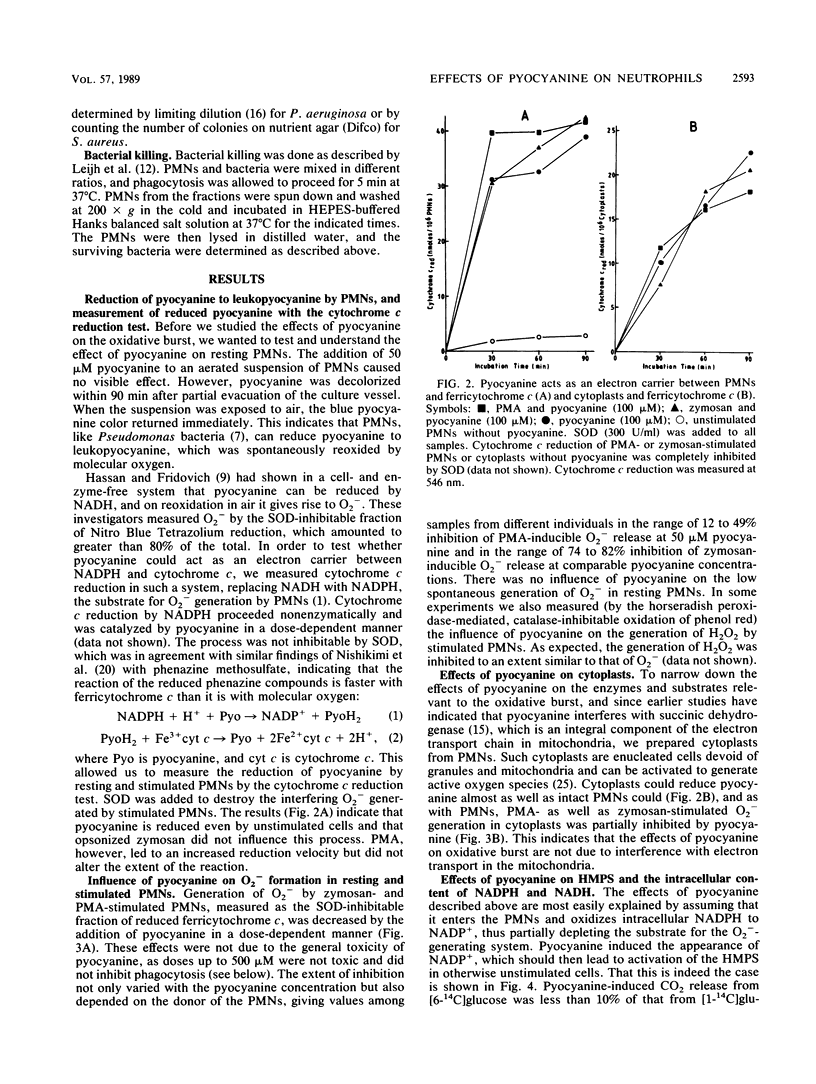Abstract
The effects of pyocyanine (phenazinium, 1-hydroxy-5-methyl-hydroxide, inner salt) on oxidative burst in human polymorphonuclear leukocytes were studied by several different approaches. In a cell- and enzyme-free system, pyocyanine oxidized NADPH. The reduced pyocyanine could be measured by its reaction with ferricytochrome c. It was shown by this assay that resting as well as phorbol myristate acetate- or zymosan-stimulated granulocytes reduced pyocyanine. The effect was independent of mitochondria, as cytoplasts were similarly active. Measurement of the hexose monophosphate shunt in intact granulocytes in the presence of pyocyanine indicated a concentration-dependent activation of the shunt without the generation of O2-, suggesting that pyocyanine oxidizes NADPH to NADP+ when it enters granulocytes. Intracellular NADPH in granulocytes was indeed lowered by almost 40% after incubation with pyocyanine. It is by this shuttling of reduction equivalents, leading to the partial depletion of NADPH, that pyocyanine affects the observed concentration-dependent partial inhibition of the phorbol myristate acetate- and zymosan-stimulated generation of O2-. A further consequence was that the intracellular killing of Staphylococcus aureus was also partially suppressed, particularly at higher loads of granulocytes with bacteria. Phagocytosis was not inhibited by pyocyanine concentrations as high as 500 microM. Pyocyanine did not affect the intracellular killing of Pseudomonas aeruginosa. The possible relevance of these findings to the course of mixed hospital infections in immunocompromised patients is discussed.
Full text
PDF





Selected References
These references are in PubMed. This may not be the complete list of references from this article.
- Babior B. M. Oxidants from phagocytes: agents of defense and destruction. Blood. 1984 Nov;64(5):959–966. [PubMed] [Google Scholar]
- Badwey J. A., Karnovsky M. L. Active oxygen species and the functions of phagocytic leukocytes. Annu Rev Biochem. 1980;49:695–726. doi: 10.1146/annurev.bi.49.070180.003403. [DOI] [PubMed] [Google Scholar]
- Baehner R. L., Nathan D. G. Leukocyte oxidase: defective activity in chronic granulomatous disease. Science. 1967 Feb 17;155(3764):835–836. doi: 10.1126/science.155.3764.835. [DOI] [PubMed] [Google Scholar]
- Bøyum A. Isolation of lymphocytes, granulocytes and macrophages. Scand J Immunol. 1976 Jun;Suppl 5:9–15. [PubMed] [Google Scholar]
- Clawson C. C., Repine J. E. Quantitation of maximal bactericidal capability in human neutrophils. J Lab Clin Med. 1976 Aug;88(2):316–327. [PubMed] [Google Scholar]
- Green D. R., Faist E. Trauma and the immune response. Immunol Today. 1988 Sep;9(9):253–255. doi: 10.1016/0167-5699(88)91300-X. [DOI] [PubMed] [Google Scholar]
- Hassan H. M., Fridovich I. Mechanism of the antibiotic action pyocyanine. J Bacteriol. 1980 Jan;141(1):156–163. doi: 10.1128/jb.141.1.156-163.1980. [DOI] [PMC free article] [PubMed] [Google Scholar]
- MASSEY V., SINGER T. P. Studies on succinic dehydrogenase. VI. The reactivity of beef heart succinic dehydrogenase with electron carriers. J Biol Chem. 1957 Dec;229(2):755–762. [PubMed] [Google Scholar]
- Mandell G. L. Bactericidal activity of aerobic and anaerobic polymorphonuclear neutrophils. Infect Immun. 1974 Feb;9(2):337–341. doi: 10.1128/iai.9.2.337-341.1974. [DOI] [PMC free article] [PubMed] [Google Scholar]
- Markert M., Andrews P. C., Babior B. M. Measurement of O2- production by human neutrophils. The preparation and assay of NADPH oxidase-containing particles from human neutrophils. Methods Enzymol. 1984;105:358–365. doi: 10.1016/s0076-6879(84)05048-5. [DOI] [PubMed] [Google Scholar]
- Miller K. M., Dearborn D. G., Sorensen R. U. In vitro effect of synthetic pyocyanine on neutrophil superoxide production. Infect Immun. 1987 Mar;55(3):559–563. doi: 10.1128/iai.55.3.559-563.1987. [DOI] [PMC free article] [PubMed] [Google Scholar]
- Mühlradt P. F., Tsai H., Conradt P. Effects of pyocyanine, a blue pigment from Pseudomonas aeruginosa, on separate steps of T cell activation: interleukin 2 (IL 2) production, IL 2 receptor formation, proliferation and induction of cytolytic activity. Eur J Immunol. 1986 Apr;16(4):434–440. doi: 10.1002/eji.1830160421. [DOI] [PubMed] [Google Scholar]
- Nishikimi M., Appaji N., Yagi K. The occurrence of superoxide anion in the reaction of reduced phenazine methosulfate and molecular oxygen. Biochem Biophys Res Commun. 1972 Jan 31;46(2):849–854. doi: 10.1016/s0006-291x(72)80218-3. [DOI] [PubMed] [Google Scholar]
- Nutman J., Berger M., Chase P. A., Dearborn D. G., Miller K. M., Waller R. L., Sorensen R. U. Studies on the mechanism of T cell inhibition by the Pseudomonas aeruginosa phenazine pigment pyocyanine. J Immunol. 1987 May 15;138(10):3481–3487. [PubMed] [Google Scholar]
- Rajkovic I. A., Williams R. Rapid microassays of phagocytosis, bacterial killing, superoxide and hydrogen peroxide production by human neutrophils in vitro. J Immunol Methods. 1985 Apr 8;78(1):35–47. doi: 10.1016/0022-1759(85)90327-8. [DOI] [PubMed] [Google Scholar]
- Roos D., Voetman A. A. Preparation and cryopreservation of cytoplasts from human phagocytes. Methods Enzymol. 1986;132:250–257. doi: 10.1016/s0076-6879(86)32012-3. [DOI] [PubMed] [Google Scholar]
- Roos D., de Boer M. Purification and cryopreservation of phagocytes from human blood. Methods Enzymol. 1986;132:225–243. doi: 10.1016/s0076-6879(86)32010-x. [DOI] [PubMed] [Google Scholar]
- Sorensen R. U., Klinger J. D., Cash H. A., Chase P. A., Dearborn D. G. In vitro inhibition of lymphocyte proliferation by Pseudomonas aeruginosa phenazine pigments. Infect Immun. 1983 Jul;41(1):321–330. doi: 10.1128/iai.41.1.321-330.1983. [DOI] [PMC free article] [PubMed] [Google Scholar]
- Wilson R., Sykes D. A., Watson D., Rutman A., Taylor G. W., Cole P. J. Measurement of Pseudomonas aeruginosa phenazine pigments in sputum and assessment of their contribution to sputum sol toxicity for respiratory epithelium. Infect Immun. 1988 Sep;56(9):2515–2517. doi: 10.1128/iai.56.9.2515-2517.1988. [DOI] [PMC free article] [PubMed] [Google Scholar]


